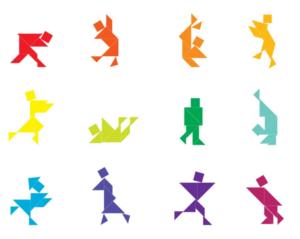How are languages formed and how does a word become a word?
Have you ever looked at the object in your hand and wondered how it got its name? Why is a book called a book? And why is a word a word?
I studied Linguistics at university, and as part of my final year dissertation, I carried out a linguistic experiment to examine the phenomenon of how words are formed.
The experiment made use of tangram shapes (Chinese geometric puzzle shapes), where pairs of participants located in different rooms were given matching sets of 16 printed tangrams. One person received the shapes in a prearranged order, with their partner getting the same shapes in a random order. Some shapes were relatively simple, others more complex.
Their task was to work together using a text-based chat tool to get the second person to successfully arrange the shapes in the same order as their partner as quickly as possible. They could not see one another or see the other person’s tangrams. Multiple rounds of the experiment were carried out.

The participants were given no clue as to the purpose of the experiment. What I was specifically examining was their approach to describing the various shapes and how the names they came up with for each shape evolved in the early rounds of the experiment, before settling on an agreed term once they had a clear mutual understanding of the shape.
For example, in the first round of the experiment, one pair referred to a simple-looking shape as ‘the one that looks like a cat’. In the second round and every subsequent round, this was referred to simply as ‘the cat’.
A more complex shape was initially described by one person as ‘the one that looks a bit like a boat with hands on top’. Their partner replied that the hands looked more like ears. In the second round, this became ‘the boat with the ears on top’. In the third round, it was enough to say ‘boat ears’. The term ‘boat ears’ was then used repeatedly in all subsequent rounds whenever this shape was discussed, enabling the participants to complete the task with maximum efficiency. There would have been no point in one partner continuing to refer to the shape above as ‘boat hands’ and the other partner as ‘boat ears’, as it would only result in confusion.
The experiment neatly shows how a new word is born between two people. Initially, there are competing ways to describe an object. Once one version takes precedence over the other, the losing one is quickly forgotten and the winner is established.
The same principle applies to the formation of new words in language in general. In real-world communities with more than two people, the same process occurs on a larger scale and over a longer period of time. The members of a community need to agree on a single accepted word for an item or concept to enable them to communicate as efficiently as possible.
Competing words may exist for an item, but once one word becomes accepted among a large enough portion of the community, it will soon be accepted among the entire community.
In fact, the experiment also shows how and why different languages develop in opposing directions to one another and have different words for the same concepts. For the ‘boat ears’ tangram shape, another pair of participants described it as a ‘ship with a chimney on top’, subsequently shortened to ‘ship chimney’. Each pair of participants essentially created their own language that only they spoke.
Questions? Comments?
Leave a reply below if you’d like to find out more about the experiment or how words and languages are formed.
And if you’re interested in professional English translations to promote your business or destination, hit the button below to send me a message.
